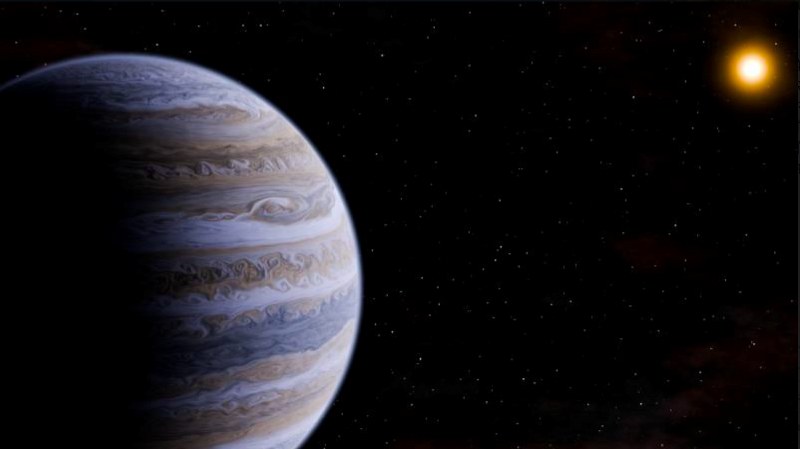
Nearby 'Super-Jupiter' planet discovered; IIT Kanpur professor part of international team of astronomers
Kolkata: In a ground-breaking discovery, an international team of astronomers, including an IIT Kanpur professor, has discovered a giant planet orbiting a nearby star similar to our own Sun.
Assistant Professor Dr. Prashant Pathak at IIT Kanpur’s Dept. of Space, Planetary & Astronomical Sciences & Engineering (SPASE) was part of the team that discovered the planet, Epsilon Indi Ab, or Eps Ind Ab for short, is classified as a 'super-Jupiter' due to its mass, which exceeds that of Jupiter by at least six times, making it significantly larger than any planet in our solar system.
Eps Ind Ab is the first-ever mature exoplanet (a planet beyond our solar system) to be discovered using direct imaging technique.
The details of the discovery and the research behind it has been published in the world's leading multidisciplinary science journal, Nature.
Using the James Webb Space Telescope's (JWSTs) Mid-InfraRed Instrument (MIRI), an international team of astronomers has directly imaged a new exoplanet orbiting the K5V-type star Epsilon Indi A (also known as HD 209100 or HIP 108870).
Direct imaging of a nearby mature exoplanet marks a significant milestone in the realm of space exploration.
Unlike indirect methods that infer a planet's existence through its gravitational influence or the dimming of starlight as it passes in front of its host star, direct imaging allows astronomers to directly observe the exoplanet itself.
This breakthrough shows the incredible capabilities of the JWST with its unique combination of high sensitivity, infrared capabilities, and advanced imaging techniques.
Such advancements pave the way for future discoveries and deepen our quest to uncover the mysteries of distant worlds.
The newly discovered planet is located 12 light-years away from us. The planet is quite cold, with a temperature of about -1°C (30°F). Its orbit is also immense, circling its star at a distance 28 times greater than the distance between our Earth and the Sun.

“We were excited when we realised we had imaged this new planet”, said Elisabeth Matthews, a researcher at the Max Planck Institute for Astronomy in Heidelberg, Germany and the lead author of the research article. “To our surprise, the bright spot that appeared in our MIRI images did not match the position we were expecting for the planet,” Matthews points out.
“Previous studies had correctly identified a planet in this system but underestimated mass and orbital separation”. With the help of the JWST, the team was able to set the record straight.
"This discovery is a major milestone in exoplanet research and sets the stage for future discoveries, bringing us one step closer to uncovering the mysteries of planetary systems beyond our own," said Prof. Manindra Agrawal, Director, IIT Kanpur.
"Being able to directly image a planet close to us provides an unprecedented opportunity for in-depth study. Dr. Prashant Pathak’s work in collaboration with international experts highlights the global contributions of IIT Kanpur in advancing our understanding of space."
Dr. Prashant Pathak, Assistant Professor, Dept. of Space, Planetary & Astronomical Sciences & Engineering (SPASE), IIT Kanpur and a key member of the research team, explained, "This discovery is exciting because it gives us a chance to learn more about planets that are very different from our own. The planet’s atmosphere appears to have an unusual composition that indicates a high metal content and a different carbon-to-oxygen ratio than we see on our own solar system planets.
“This opens up fascinating questions about its formation and evolution. By studying Eps Ind Ab and other nearby exoplanets, we hope to gain a deeper understanding of planetary formation, atmospheric composition, and the potential for life beyond our solar system.”
Previous attempts to study the giant planet Eps Ind Ab using radial velocity measurements were not successful as the planet's orbital period is around 200 years and the data from short-term observations was not sufficient to accurately determine the planet's properties.
Hence the team decided to follow a direct imaging approach. As the overwhelming brightness of the host star would typically hinder detecting exoplanet’s faint light.
The team used JWSTs MIRI camera equipped with a coronagraph, to block the starlight, effectively creating an artificial eclipse. This technique enables detecting faint signals around bright objects, similar to observing solar corona during an eclipse. Eps Ind A proximity to Earth (only 12 light-years) proved advantageous.
Nearby planetary systems can be resolved using large telescopes such as JWST’s 6.5 m aperture, enhancing the angular separation between the star and planet. MIRI's ability to observe in the thermal infrared, where cold objects like planets emit strong radiation, made it the ideal instrument for this ground-breaking observation.
This work is only a first step towards characterising Eps Ind Ab. “Our next goal is to obtain spectra which provide us a detailed fingerprint of the planet’s climatology and chemical composition,” said Thomas Henning, Emeritus Director at MPIA, co-PI of the MIRI instrument, and a co-author of the underlying article.
“In the long run, we hope to also observe other nearby planetary systems to hunt for cold gas giants that may have escaped detection. Such a survey would serve as the basis for a better understanding of how gas planets form and evolve.”
Support Our Journalism
We cannot do without you.. your contribution supports unbiased journalism
IBNS is not driven by any ism- not wokeism, not racism, not skewed secularism, not hyper right-wing or left liberal ideals, nor by any hardline religious beliefs or hyper nationalism. We want to serve you good old objective news, as they are. We do not judge or preach. We let people decide for themselves. We only try to present factual and well-sourced news.







